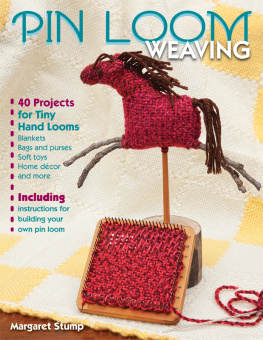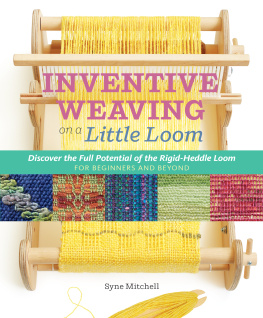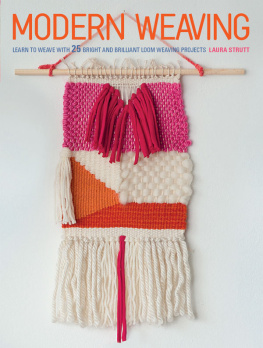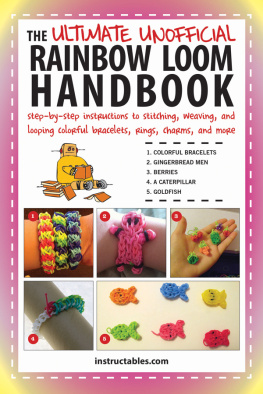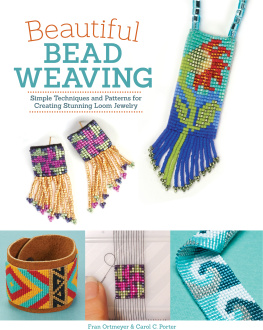Weaving Made Easy
17 Projects Using a Rigid-Heddle Loom
Liz Gipson

CONTENTS
The Projects
Introduction
Weaving is an enchantress. Im not sure exactly how I came under her spell. I was fortunate to learn to weave at a young age. All things fiber charmed my imagination. As a child, I would wrap my little hands around the fence surrounding the llama at the petting zoo in order to prevent my grandmother from hauling me away. I read in a book that you could weave with that llamas coat, and I wanted her to teach me how! Working with yarn simply makes me happy, and we tend to stick with things that make us happy.
Weaving, for me, is also a small act of rebellion. We are so far removed from how the items we depend on every dayfood, clothing, and shelterare made. Now, Im not even close to making everything I wear or all the textiles in my home, but at least I know what it takes to make the fabric that I depend on.
This little loomthe rigid heddleis the perfect avenue for you to discover what weaving has to offer. Small and portable, its the ideal blend of ease and functionality. Weaving is one of the fastest ways to produce cloth, and it meshes beautifully with all of your other craft skills. If you sew, youll be in heaven creating your own fabric. If you knit or crochet, you can combine these techniques for truly unique garments. If you spin, you can create yarns for woven cloth that no one else can buy. If you have never tackled any other craft in your life, you learned all you need to know in third-grade math. Really. Its that easy!
Its time to get weaving, and this little loom is your ticket to the party.
The Basics
With every new avocation comes a new vocabulary. Weaving is no exception, but fortunately, there are only a few simple terms to master. When first used, the terms are printed in boldface type; see for all terms. Woven cloth is formed when parallel yarns that are held taut are interlaced by a second yarn. As a unit, the taut yarn is called the warp; individual yarns (also called threads) are called warp ends. The yarn that travels over and under (or weaves) between the warp ends is called the weft; individual weft threads are called picks. Woven cloth is made by interlacing the warp ends with weft picks. Long ago, weavers came up with a variety of looms to hold the warp ends taut to facilitate interlacing them with the weft picks.
The rigid heddle is perhaps the most straightforward loom available on the market. The warp ends are threaded alternately through holes in plastic bars (heddles) and through the slots between the bars. As a unit, these holes and slots are called the rigid heddle. It is also referred to as the beater because it is used to beat the weft into place. The rigid heddle is lifted or lowered to raise or lower the warp ends to form a shed through which the weft is passed. Think of the shed as the space that shelters the weft. Shed blocks provide a means to hold the rigid heddle in the lifted or lowered position so both of your hands are free to manipulate the weft. The weft is most efficiently passed through the shed by means of a stick shuttle, a thin flat piece of wood around which the weft yarn is wrapped. By alternating sheds and beating picks of yarns, the weft yarn passes alternately over and under the warp ends to weave cloth.
The Rigid-Heddle Loom
Cloth Beam Holds the woven cloth at the front of the loom.
Warp Beam Holds the warp threads at the back of the loom.
Shed Blocks Holds the rigid heddle in the up or down position.
Rigid Heddle Apparatus through which the warp is threaded and with which the weft yarn is beat or aligned perpendicular to the warp.
Front Apron Rod Where the warp is tied and tensioned at the front of the loom.
Back Apron Rod Where the warp is tied onto the back of the loom.
Stand Holds the loom at a comfortable height for weaving. If you dont have a stand, prop the back of the loom on the edge of a table and rest the front in your lap.
Shed The space between adjacent warp threads through which the weft travels.
Shuttle Holds the weft.
Warp The yarns stretched on the loom.
Weft Yarn that interlaces the warp in an over-under fashion.
Brake Allows the tension of the warp to be released or tightened.
Whats in a Name?
Although the details are lost to time, it would have been nice if whoever named the rigid-heddle loom had come up with a sexier name. Although rigid heddle describes the loom perfectly, it sounds so boring for such an ingenious invention.
Accessories
Calculator To help with the basic math needed to determine warp and weft lengths and widths and to figure yarn amounts.
Clamps Used to secure the loom.
Tape measure Used to measure weaving progressplan to always have one handy.
Embroidery or tapestry needle Used for finishing work and fixing mistakes.
Fray Check A liquid plastic that will safely secure woven cloth to keep it from fraying.
Heddle hook A thin flat hook with an easy-grip handle used to thread the warp yarns through the holes and slots in the rigid heddle.
Inch gauge or ruler Used to determine the thickness of yarns.
Pencil or pen For taking notes as you weave.
Pick-up stick Used to manipulate the warp; also comes in handy to clear the shed when using novelty or sticky yarns in the warp.
Project planning cards or note paper For taking notes.
Scissors For cutting yarns.
Stick shuttle Any of a number of styles of thin flat wood that holds the weft yarn.
Tapestry beater or fork Use to beat the weft (not shown).


